My motorcycle travel adventure in 2005 had me heading southeast, down through Kentucky, Tennessee, Georgia, the Carolinas, and Virginia, then back up the East Coast as far as Pennsylvania. I have an interest in the Civil War and would be visiting Civil War Battlefields. The first was Shiloh National Military Park on the southern border of Tennessee, the earliest and westernmost battle of the war. The fighting pitted inexperienced soldiers from both the North and South against each other. They fought with a frenzy and violent hysteria. It is said, those who were killed at Shiloh, 3,024 Yankee and Rebel soldiers, certainly went to Heaven because all had spent their time in Hell.
The next stop was the Stones River Battlefield, known as the deadliest battle of the war. There were 23,746 casualties at Stones River.
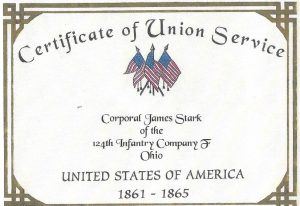
Heading east and dropping down into northern Georgia, I was especially looking forward to my visit to the Chickamauga Battlefield. An enlisted soldier had been killed there by the name of Corporal James Stark. Stark was my great, great uncle, son of my great, great grandfather, Henry Stark. I knew quite a bit about Corporal Stark. I have his military records and letters from attendees at his wedding which validated the survivor benefits his widow, Anna Stark, and their two children would receive after his death. I knew the unit he was attached to in the 124th Ohio Volunteers. The Chickamauga Military Park visitor’s center was able to give me the location within the park where his unit fought on the day he was killed. There were three skirmishes that day, each marked with a monument and I felt if I went to each, I would feel some vibes telling me that was the place my uncle fell. Can’t say I felt any vibes, but it was an emotional tour.
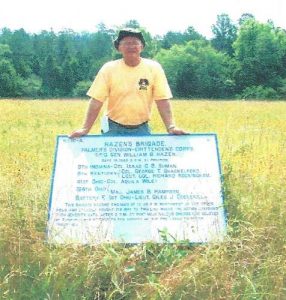
Although the Civil War sites required most of my time on that trip, it was my next stop that I was particularly excited about. I was going to spend a week training to fly hang gliders at the Lookout Mountain Hang Glider School.
Headquarters for the school was located at the top of Lookout Mountain. There was a concrete ramp outside the school where hang glider pilots were stepping off to glide 2,000 feet to a landing field below. Could I do that? Heck, yes. Just help me strap on those cloth wings.
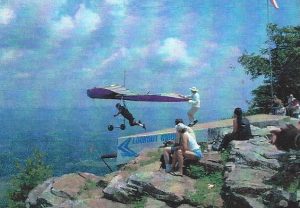
My training would include daily flights running off a hilltop, practicing flight control and landings, and three tandem flights with an instructor while being towed to 2,000 feet above the landing field. I discovered there was much more to controlling a hang glider than I realized and the impulse to step off that concrete ramp that first day would have undoubtedly resulted in a spin into the rocks and trees of Lookout Mountain.
My training went well that week, although I wasn’t quite ready for a solo launch off that headquarters ramp. Maybe next time.
I next headed for North Carolina where I planned to visit another high school football teammate, Tom Catalano. Tom had been a career Army officer and he and I planned to tour the Army’s Airborne and Special Operations Museum at Fort Bragg in Fayetteville. Following a great tour, I spent the night as a guest of Tom and his gracious wife.
The following day I took a ferry to the Outer Banks. Upon arrival I rode to Kitty Hawk to do the obligatory tour of the Wright Brothers National Monument. I had visited once before but had not spent much time there.
The Wright Brothers were amazing pilots, having acquired their skills strictly by trial and error. Their first successful controlled flight on December 17, 1903 flew 120 feet. The fourth flight of the day lasted 59 seconds and covered 852 feet. On the 100th anniversary of that first flight, an identical Wright Flyer was constructed and several very qualified test pilots were asked to fly it. The best they could do was 90 feet, 30 feet short of Wilbur’s very first attempt. My feeble attempts to fly hang gliders didn’t seem so bad after all.
My last Civil War visit on this trip was to the Pamplin Historic Park in Petersburg, Virginia. The battle at Petersburg was waged on these grounds and resulted in General Robert E Lee surrendering his Confederate Army at the Appomattox Court House. If anyone wants to experience the Civil War drama and can only visit one site, go to Pamplin Historic Park.
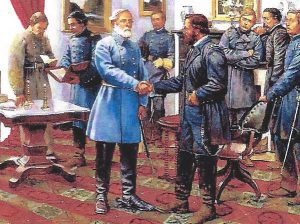
The realism of the animations and displays will take you back to that desperate war when 655,000 Americans lost their lives fighting for what they believed to be their patriotic duty. Pamplin is dedicated to the soldiers of both the North and the South. The museum invites you to select an audio guide for a recorded tour from one of thirteen different Civil War soldiers. I selected Lieutenant Wood of the Union Army from Pennsylvania to describe the various rooms I was entering with their static and anatomical displays revealing different phases of the Civil War experience, such as: Camp Life before Battle, Being on the March, Trial by Fire, Death on the Battlefield, Surviving the Field Hospital, and Winter Camp. In the Trial by Fire display, tourists are led across a tree-lined field with the enemy visible ahead pointing and firing rifles at you. Bullets buzz past your ears, cannons explode nearby, and cries of anguish and pain are heard all about you. You find yourself instinctively ducking the mini balls as you march forward into the apocalypse. What an experience. What a museum.
And what a fascinating 3,000-mile, two week ride it had been.
2007
The title of my motorcycle journal in 2007 was “Downeast”. My direction would actually be northeast but sailing ships out of Boston in the 1800s used to sail east up the coast to catch the trade winds and since that was a downwind sail the direction was referred to as downeast. I would be heading downeast eventually taking a ferry out of Bar Harbor, Maine to Halifax, Nova Scotia.
En route to Maine, I stopped and camped in Pennsylvania with plans to tour the Gettysburg Battleground. Jim Hellauer, a high school classmate of mine, lives in Pennsylvania and drove over to join me for the tour. Jim and I had played football together. He and I reconnected in recent years and trade visits back and forth while in Florida at our winter snowbird retreats.
Friends had told me the best way to do Gettysburg is to hire a guide who will drive your car and narrate the battle’s history. Doug was our guide and not only was he a knowledgeable historian but could be called an actor as well. While describing one of the more tragic skirmishes of that battle Doug actually had tears in his eyes.
After the tour and lunch, Jim and I then visited President Eisenhower’s retirement home, his Gettysburg Farm. The buildings are furnished as they were in the early 1960s with original dial telephones and small black and white television sets.
Leaving Pennsylvania, my next stop was Colchester, Connecticut. My great, great, great, grandfather, Ebenezer Fletcher Stark was born in Colchester but emigrated as a 16-year-old with his family, becoming early pioneers in a settlement on the banks of Lake Erie that years later became the major metropolis, Cleveland, Ohio. I was researching Ebenezer’s background for a historical novel I was writing titled, “Great Lakes Skipper.” A librarian in Colchester gave me access to a locked room of early Colchester history. I spent an interesting afternoon among the archives, compiling my notes.
Once in Maine, I paid a visit to the L.L.Bean store in Freeport and then spent a night with a former Navy squadron mate, Bill Locke, in Brunswick, Maine. Bill was a career officer and in retirement had become head honcho of the VP-21 website and newsletter. Bill was one of the beta readers for my book, Two Turning, Two Burning, Memoir of a Naval Aviator.
Bill took me on a tour of the newly renovated naval air station. It was very impressive. The old Quonset huts had been replaced with townhouses and a new control tower, which according to Bill, was the most technically advanced of any in Maine. So, after spending millions, the government then decided to close the base. Who is in charge of these things?
Locke invited a couple former squadron shipmates to his home that evening for a pizza party. Great fun.
The ferry from Bar Harbor to Nova Scotia took several hours. The ship, quite large, is actually a catamaran with twin hulls. Most cats ride just above the surface of the water and travel at high speed. This ship didn’t quite get above the surface and being a stormy day, we experienced a very rough, sea tossed ride across the water. Walking around on board was difficult and many passengers became sick. My only concern was my motorcycle parked on a lower deck. It was tied down but if one of the surrounding bikes broke loose, damage would result. Fortunately, all survived without a scratch.
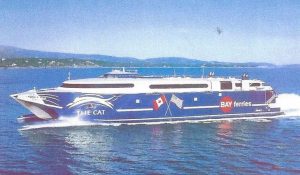
My wife, Michele, was going to fly into Halifax and join me for four days of two-up’ing around Nova Scotia. The sister-in-law of another high school friend, Bill Robinson, lives in Halifax. Dorothy Keays, arranged a guest suite for Michele and me in her condo. What an incredible hostess she was. She stocked our refrigerator with a variety of beverages and all kinds of snacks. After a day of touring, each night Dorothy would slip a note under our door of additional sights we might consider seeing.
We visited Peggy’s Cove, which in addition to being a beautiful waterfront village, was the site of the 1999 Swiss air disaster, flight 1800. We also rode out to the Bay of Fundy with its forty-foot tides. Amazing. The following day we walked through Fairview Cemetery where 128 of the Titanic ship victims are buried. In the Titanic movie, Jack Dawson (Leonardo DiCaprio) was actually a fictional character created for the film. His movie name was taken from one of the drowned crewmembers who worked in the boiler section. Dawson’s body is buried in Fairview Cemetery. J. Dawson’s gravestone is covered with flowers and teddy bears by teenage fans who do not realize the real owner of that name. Dawson the boiler-man would be very pleased.
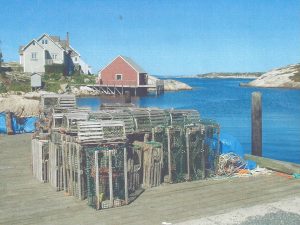
Peggy’s Cove, Nova Scotia
Touring the Halifax Historical museum, we learned about the Halifax Harbor disaster during WW I. An ammunitions ship loaded with TNT collided with a steamship. The explosion was greater than the power of the two atomic bombs combined dropped on Japan. It blew all of the water out of the harbor and flattened the city for miles around. Two thousand people were killed. How tragic.
After Michele flew back to Indiana, I decided rather than take the ferry back to Maine to ride up through Canada. My travels on my return to Indiana allowed some special time in New Hampshire. Kancamagus Pass is only 52 miles long but its scenic beauty and roadside white-water creeks demand that you stop every few minutes to try to capture the magnificence on film. Such splendor. Yes, I was still using a film camera in 2007.
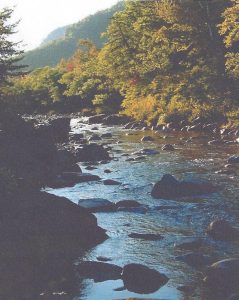
I also road up to the 6,280-foot top of Mount Washington in New Hampshire. I was surprised to see many of the buildings at the top had huge logging chains draped over their roofs. Then I read Mount Washington once recorded wind speeds of 231 MPH. Hmmm, mystery solved.
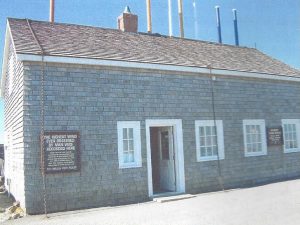
My 19-day travel of 4,400 miles had been another lifetime highlight.
It was that long ago when we were together at Gettysburg. Where did the years go?
Jim Hellauer
Another great trip/story Jim. Thanks for that.
Most interesting history, Jim!
Also, I remember your motorcycle trip in NE with Michele. You stopped to say hello while I was in ME.